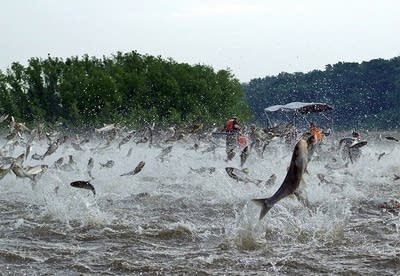Is Minnesota ready to fight Asian carp invasion?
Go Deeper.
Create an account or log in to save stories.
Like this?
Thanks for liking this story! We have added it to a list of your favorite stories.

We may learn today whether Asian carp have moved farther up in the Mississippi and St. Croix Rivers. The Minnesota DNR is expected to release results of studies about the carp's advance later today.
The voracious invader is swimming up the Mississippi River. The big questions are, how far will it go, and what will we do about it?
Asian carp were first introduced to North America by fish farmers in the southern U.S. They imported the carp to control plant growth in fish ponds. But the big fish with no natural enemies soon escaped the ponds and began eating -- and leaping -- its way north. And east and west. Carp have been found in Lake Pepin and in lower reaches of the St. Croix River.
Unsuspecting boaters up and down the Mississippi have been injured when 25-to-50-pound silver carp, excited by the boat's motor, jump high in the air and sometimes land in the boat.
Turn Up Your Support
MPR News helps you turn down the noise and build shared understanding. Turn up your support for this public resource and keep trusted journalism accessible to all.
Asian carp is the generic term for one of four species of fish that are posing threats. The silver carp is the most notorious, for its acrobatic antics. It's a YouTube favorite.
And the carp are causing as much havoc underwater. Phil Moy studies Asian carp at the University of Wisconsin Sea Grant Institute.
"These things are robbing everything else that depends on the productivity of the water -- the tiniest fish, the minnows that then feed larger fish that then feed us, all rely on plankton -- and here we have a great big fish, and a lot of them, taking the food from everyone else," said Moy.

The carp can eventually dominate water systems, squeezing out natives and favorite sport fish. The prospect of walleye lakes in northern Minnesota being overrun by Asian carp is not a happy one.
In Illinois, small armies of federal and state workers have been trying to stop the carp that's infesting the Chicago River system before they reach Lake Michigan. The big fear is that the fish would pass from the rivers and infest all of the Great Lakes, threatening lake trout and other native species.
There's a lot less attention paid to the carp's march up the Mississippi River. But nonprofit groups and government agencies are worried. The National Park Service began testing the Mississippi for carp DNA this summer. At least two studies in the last seven years have called for action.
"I think we have to very seriously explore a physical barrier," said Whitney Clark, director of Friends of the Mississippi River.
Clark says Lock and Dam #1, the Ford Dam in St. Paul, would be a logical place to try to stop carp. The lock there allows recreational and some commercial boat traffic to pass, but Clark says it might be possible to keep the carp from squeezing through.
"If we could devise an effective barrier within the lock, a sound or electric barrier that would be pretty effective, that might be the way to address that," he said. "If that is determined not to be as effective as we'd like, then obviously closing the lock might be something we would need to study."
So far, permanently abandoning locks has not been on the table.
Some experts think we won't be able to stop Asian carp from spreading where it will, and we'll need to find ways to control it wherever it goes.
Charlie Wooley with the U.S. Fish and Wildlife Service in St. Paul says researchers are looking for chemical means of control, like those used for sea lamprey in the Great Lakes.
"And we're looking at biobullets. These are an encapsulated fish poison that would be ingested by an Asian carp, and it would then break down in the gut of the Asian carp and kill the Asian carp," he said.
It would be tailor-made to kill carp and not other fish, Wooley says. Or biologists could use hormones to attract the carp so they'd be easier to kill.
But all these efforts are expensive, and so far the federal government and states along the Mississippi River, have not come up with much money. Last year the federal Great Lakes Restoration Initiative directed millions of dollars to the effort in the Chicago area.
The Minnesota Legislature allocated money to repair the Coon Rapids dam, a project justified in part as a barrier to Asian carp. But that dam is fairly low; it's regularly overtopped in floods.
In any case, it will do nothing to prevent the carp from getting into the St. Croix or Minnesota Rivers.
Dear reader,
Your voice matters. And we want to hear it.
Will you help shape the future of Minnesota Public Radio by taking our short Listener Survey?
It only takes a few minutes, and your input helps us serve you better—whether it’s news, culture, or the conversations that matter most to Minnesotans.





